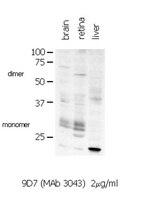Abundance of gap junctions at glutamatergic mixed synapses in adult Mosquitofish spinal cord neurons.
Serrano-Velez, JL; Rodriguez-Alvarado, M; Torres-Vazquez, II; Fraser, SE; Yasumura, T; Vanderpool, KG; Rash, JE; Rosa-Molinar, E
Frontiers in neural circuits
8
66
2014
Zobrazit abstrakt
"Dye-coupling", whole-mount immunohistochemistry for gap junction channel protein connexin 35 (Cx35), and freeze-fracture replica immunogold labeling (FRIL) reveal an abundance of electrical synapses/gap junctions at glutamatergic mixed synapses in the 14th spinal segment that innervates the adult male gonopodium of Western Mosquitofish, Gambusia affinis (Mosquitofish). To study gap junctions' role in fast motor behavior, we used a minimally-invasive neural-tract-tracing technique to introduce gap junction-permeant or -impermeant dyes into deep muscles controlling the gonopodium of the adult male Mosquitofish, a teleost fish that rapidly transfers (complete in less than 20 mS) spermatozeugmata into the female reproductive tract. Dye-coupling in the 14th spinal segment controlling the gonopodium reveals coupling between motor neurons and a commissural primary ascending interneuron (CoPA IN) and shows that the 14th segment has an extensive and elaborate dendritic arbor and more gap junctions than do other segments. Whole-mount immunohistochemistry for Cx35 results confirm dye-coupling and show it occurs via gap junctions. Finally, FRIL shows that gap junctions are at mixed synapses and reveals that greater than 50 of the 62 gap junctions at mixed synapses are in the 14th spinal segment. Our results support and extend studies showing gap junctions at mixed synapses in spinal cord segments involved in control of genital reflexes in rodents, and they suggest a link between mixed synapses and fast motor behavior. The findings provide a basis for studies of specific roles of spinal neurons in the generation/regulation of sex-specific behavior and for studies of gap junctions' role in regulating fast motor behavior. Finally, the CoPA IN provides a novel candidate neuron for future studies of gap junctions and neural control of fast motor behaviors. | 25018700
 |
Electrical synaptic transmission in developing zebrafish: properties and molecular composition of gap junctions at a central auditory synapse.
Yao, C; Vanderpool, KG; Delfiner, M; Eddy, V; Lucaci, AG; Soto-Riveros, C; Yasumura, T; Rash, JE; Pereda, AE
Journal of neurophysiology
112
2102-13
2014
Zobrazit abstrakt
In contrast to the knowledge of chemical synapses, little is known regarding the properties of gap junction-mediated electrical synapses in developing zebrafish, which provide a valuable model to study neural function at the systems level. Identifiable "mixed" (electrical and chemical) auditory synaptic contacts known as "club endings" on Mauthner cells (2 large reticulospinal neurons involved in tail-flip escape responses) allow exploration of electrical transmission in fish. Here, we show that paralleling the development of auditory responses, electrical synapses at these contacts become anatomically identifiable at day 3 postfertilization, reaching a number of ∼6 between days 4 and 9. Furthermore, each terminal contains ∼18 gap junctions, representing between 2,000 and 3,000 connexon channels formed by the teleost homologs of mammalian connexin 36. Electrophysiological recordings revealed that gap junctions at each of these contacts are functional and that synaptic transmission has properties that are comparable with those of adult fish. Thus a surprisingly small number of mixed synapses are responsible for the acquisition of auditory responses by the Mauthner cells, and these are likely sufficient to support escape behaviors at early developmental stages. | 25080573
 |
Molecular and functional asymmetry at a vertebrate electrical synapse.
Rash, JE; Curti, S; Vanderpool, KG; Kamasawa, N; Nannapaneni, S; Palacios-Prado, N; Flores, CE; Yasumura, T; O'Brien, J; Lynn, BD; Bukauskas, FF; Nagy, JI; Pereda, AE
Neuron
79
957-69
2013
Zobrazit abstrakt
Electrical synapses are abundant in the vertebrate brain, but their functional and molecular complexities are still poorly understood. We report here that electrical synapses between auditory afferents and goldfish Mauthner cells are constructed by apposition of hemichannels formed by two homologs of mammalian connexin 36 (Cx36) and that, while Cx35 is restricted to presynaptic hemiplaques, Cx34.7 is restricted to postsynaptic hemiplaques, forming heterotypic junctions. This molecular asymmetry is associated with rectification of electrical transmission that may act to promote cooperativity between auditory afferents. Our data suggest that, in similarity to pre- and postsynaptic sites at chemical synapses, one side in electrical synapses should not necessarily be considered the mirror image of the other. While asymmetry based on the presence of two Cx36 homologs is restricted to teleost fish, it might also be based on differences in posttranslational modifications of individual connexins or in the complement of gap junction-associated proteins. | 24012008
 |
Trafficking of gap junction channels at a vertebrate electrical synapse in vivo.
Flores, CE; Nannapaneni, S; Davidson, KG; Yasumura, T; Bennett, MV; Rash, JE; Pereda, AE
Proceedings of the National Academy of Sciences of the United States of America
109
E573-82
2011
Zobrazit abstrakt
Trafficking and turnover of transmitter receptors required to maintain and modify the strength of chemical synapses have been characterized extensively. In contrast, little is known regarding trafficking of gap junction components at electrical synapses. By combining ultrastructural and in vivo physiological analysis at identified mixed (electrical and chemical) synapses on the goldfish Mauthner cell, we show here that gap junction hemichannels are added at the edges of GJ plaques where they dock with hemichannels in the apposed membrane to form cell-cell channels and, simultaneously, that intact junctional regions are removed from centers of these plaques into either presynaptic axon or postsynaptic dendrite. Moreover, electrical coupling is readily modified by intradendritic application of peptides that interfere with endocytosis or exocytosis, suggesting that the strength of electrical synapses at these terminals is sustained, at least in part, by fast (in minutes) turnover of gap junction channels. A peptide corresponding to a region of the carboxy terminus that is conserved in Cx36 and its two teleost homologs appears to interfere with formation of new gap junction channels, presumably by reducing insertion of hemichannels on the dendritic side. Thus, our data indicate that electrical synapses are dynamic structures and that their channels are turned over actively, suggesting that regulated trafficking of connexons may contribute to the modification of gap junctional conductance. | 22323580
 |


















